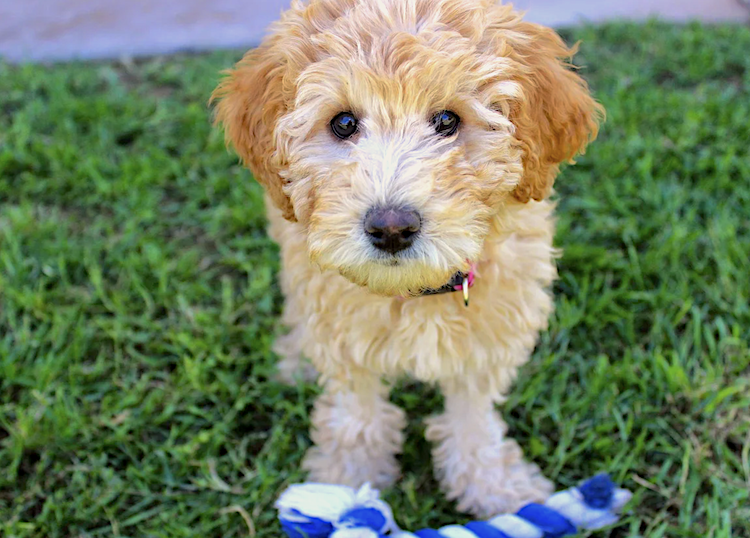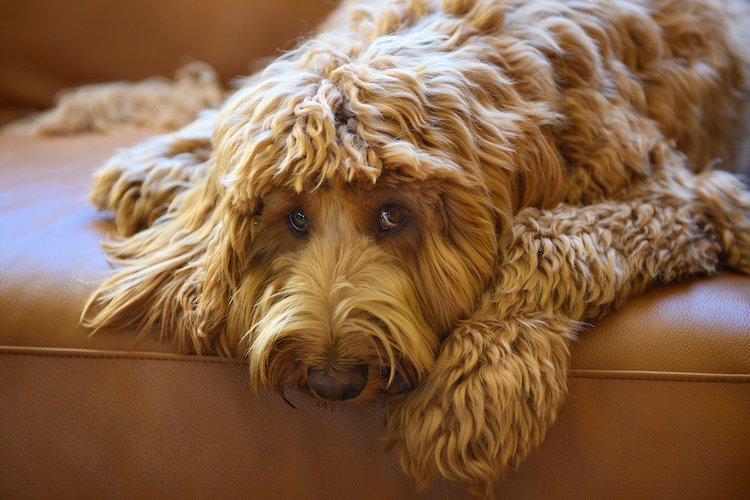
“I opened a Pandora box and released a Frankenstein monster.”
—Wally Conron, Labradoodle creator, 2019
Labradoodles described as monsters? Those adorable fluff balls loved by all?
Wally Conron, “inventor” of the Labradoodle, wasn’t disparaging the dog itself when he said he wished he had never bred a Standard Poodle and a Labrador Retriever back in 1989. Not at all.
He was bemoaning the fact that he had ignited the Labradoodle and “designer breed” craze in general. The snowball effect of people falling over themselves to have a doodle — and unethical “breeders” who got on board to fill this breeding demand — is what Wally Conron is sad about 30 years later.
As the breeding manager for the Royal Guide Dog Association of Australia, Conron had been asked to create a hypoallergenic guide dog for a blind woman in Hawaii.
Ultimately, Labradoodles are neither completely hypoallergenic nor very good guide dogs. But they have become extremely popular pets.
- Labradoodles often make great family dogs.
- However, their popularity has led to overbreeding and inbreeding.
- Whenever a breed gets incredibly popular, unethical breeders get into the mix.
- Backyard, backwoods and puppy mill breeding has damaged the health of these dogs.
- While many mixed-breed and crossbreed dogs might be considered healthier because of the mixed gene pool, this has not proven true of the Labradoodle and designer breeds in general.
- Dog lovers should be particularly careful when buying one of these trendy, overly popular designer breeds. Designer dog breeding has become a savvy industry and has learned exactly how to bamboozle the unwary dog shopper.

Why Are Labradoodles and All Doodles So Popular?
What has happened since Wally Conron’s first litter of Australian Labradoodles emerged? Here’s how Nancy Tanner, CPDT-KSA, a certified dog trainer, explains it:
“Since the experiment in Australia we now see ‘Poodling’ of pretty much everything. Bernedoodles, Borderdoodles, Cairndoodles, Dobedoodles, Cockadoodle, Cavadoodle, Mini Poodle Goldendoodle, Aussiedoodles, Mini Aussie Goldendoodle, Jackerdoodles, Teddy Bear Doodles, Double Doodles, Mini Doodle Double Doodle.…”
And why are doodles amazingly popular right now?
- Adorable factor. It seems that mixing just about anything with a poodle creates an amazingly cute pup!
- Temperament factor. Doodles are generally fun-loving, good with kids and not aggressive. Good family dogs.
- While they are not truly hypoallergenic, the decreased dander may be less of a trigger for people with dog allergies. Caveat: They need grooming. Veterinarians complain that many clients don’t pay enough attention to the basic hygiene needed to keep a doodle dandy!
Overbreeding and Inbreeding
The Labradoodle craze is just like every other breed craze where popularity leads to problematic breeding.
But because there is no American Kennel Club breed standard (the Labradoodle is not an AKC-registered breed), a lack of care about breeding for health and temperament, never mind looks, is even more of a problem than with typical bad breeding of purebreds.
Caveat: There are ethical, reputable breeders of Labradoodles and designer breeds. You just need to find them.
Unethical Breeding Leads to Health Problems in Labradoodles
Many people think that because Labradoodles are a crossbreed, they are generally healthier than a purebred. This is not true.
Unfortunately, the health and genetic problems of both Labs and poodles have shown up in the Labradoodle.
Crossbreeds have been thought to benefit from something called “hybrid vigor,” or outbreeding. This would be the opposite of inbreeding. In dogs, crossbreeding theoretically lessens the chance of genetically inherited diseases.
Is this true of the Labradoodle? Probably not. Many Labradoodles in the United States seem to be prone to diseases that plague both the poodle and the Labrador since these breeds already suffer from inbreeding.
Now inbreeding of doodles to doodles has added more insults to injury. For example, many vets describe their doodle patients as “off-the-wall crazy.”

What Are the Major Health Problems in Labradoodles?
From the Poodle, Lab and Golden Retriever side:
- Hip and/or elbow dysplasia: Labradoodles and the large doodles suffer from large dog joint problems in general. Parents can be OFA certified that they do not have hip or elbow problems. While this does not guarantee a puppy will not be affected, it is a good start.
- Eye abnormalities: Poodles, Labs and Goldens have genetic eye disorders, and the Labradoodle is prone to about 15 inherited eye problems. The parents of a puppy can be screened for some of these diseases, such as progressive retinal atrophy. Other eye diseases may show up later in life.
Poodle problems:
- Addison’s disease: Hypoadrenocorticism is an endocrine disease that affects the poodle and now affects the Labradoodle. Addison’s disease affects the pituitary gland and can cause vague signs ranging from vomiting and lethargy to acute collapse. Addison’s can be treated but requires lifelong medication. A dog suffering from Addison’s should not be bred.
- Sebaceous adenitis (SA): This rare skin condition in Poodles requires lifelong treatment, and the treatment is imperfect.
- Von Willebrand’s disease: This is a genetic bleeding disorder similar to hemophilia in people. It occurs in poodles and can show up in doodle hybrids.
Lab and Golden problems:
- Allergies: Skin allergies and ear problems plague Labs and Goldens. Many have seasonal allergies that cause intense itching. Add food allergies and you can have a dog who itches all year round until they are controlled.
- Ear infections: These can be a particular problem in Labradoodles. Allergic ear problems from the Lab side can be compounded if the doodle also has the typical hair-filled, waxy ear canal of the poodle. Hard-to-control, chronic ear infections can result.
- Lymphoma: Any dog can develop lymphoma, a form of cancer that usually affects middle-aged dogs. Lymphoma affects Labs and Goldens more than other breeds, and we see a lot of lymphoma in Labradoodles and Goldendoodles.
Other health problems in Labradoodles:
- Epilepsy: Idiopathic epilepsy is overrepresented in the Labradoodle. It can usually be controlled but requires lifelong monitoring and medication.
- Inflammatory bowel disease (IBD): This is common in many breeds, but we are seeing more IBD in doodles.
- Personality/behavioral problems: While fun-loving is one thing, a sizable portion of these dogs have a bit of a screw loose!
If you’re thinking about getting a Labradoodle, read between the lines in many of the breed descriptions.
When they say, “Doesn’t like to be left alone,” this can translate into “Cannot be left alone!” They can be attention hounds, destructive or downright irritating if not given enough exercise and lots of face time.
Many Mini Labradoodles (cross between a Miniature or Toy Poodle and a Labrador Retriever) are an exception, in my opinion. Not generally hyper, they can even seem aloof and standoffish.
Was YOUR Pet Food Recalled?
Check Now: Blue Buffalo • Science Diet • Purina • Wellness • 4health • Canine Carry Outs • Friskies • Taste of the Wild • See 200+ more brands…

Are Labradoodles Hypoallergenic?
The answer is no, or not entirely.
Although a doodle has less dander than a Labrador Retriever or a Golden Retriever does, even some of the original Australian Labradoodles back in 1989 were not hypoallergenic. Out of 10 puppies in the second litter of Labradoodles ever born, only 3 had nonallergenic coats.
Because there is such variation in the coats, all doodles need grooming — but some more than others.
- Those with tighter, curly poodle coats definitely need scheduled clipping.
- Shaggier, longhaired varieties need lots of attention to grooming as well.

Look for a Healthy Dog, Not a Designer Label
The poster child for the “designer breed,” the Labradoodle has been blamed for sparking the crossbreeding craze producing Puggles, Shih-Poos, Cavachons and millions of doodles.
And people don’t seem to mind the price tags that match their designer handbag dogs. About 6 months ago, I complimented a woman on the street on her shaggy dog. She stared at me with contempt and answered with an air that called me stupid 100 times over and said, “This is a Bernedoodle.”
My bad. It was as if I didn’t know the difference between a Louis Vuitton handbag and a knockoff, I guess.
Already familiar with the Goldendoodle, Cockapoo and Schnoodle, I suddenly brushed up on Caboodles and Jackpoos. If something is curly and walks, I just say, “What a cute doodle.”
If you’re shopping for a doodle, please put in the extra leg work to avoid health problems as well as behavioral problems. It is more likely that you will have bad actors trying to sell you a designer breed than is the case with other purebreds.
Breeder research checklist:
- Whenever possible, visit the breeder.
- Ask to see the puppy’s parents.
- Be wary of people who say they are helping their sister in another state sell her dogs. Those are generally puppy mill puppies.
- Look at the vet records and the paperwork of the puppy’s parents.
- Interview the breeder about Labradoodle health issues and ask for OFA certification and Companion Animal Eye Registry (CAER) exams.
- If a breeder tells you she has never had a problem with “any of her dogs” but has no paperwork to prove it, walk away.
Personally, I love most doodles. I do find, however, that they are often a family’s “first” dog. For first-time pet parents, doodles can be a large bundle of energy with a lot of grooming needs.
Whenever you are getting a pet, do your research, be prepared and enjoy your new family member.
In this video, Brian Ricks from Easy Retriever Training explains “everything a Labradoodle breeder might not tell you”:

References
- Rueb, Emily S., and Niraj Chokshi. “Labradoodle Creator Says the Breed Is His Life’s Regret.” New York Times. Sept. 25, 2019. https://www.nytimes.com/2019/09/25/us/labradoodle-creator-regret.html.
- “Study Reveals Genetic Diseases of Mixed-Breed, Purebred Dogs.” American Veterinary Medical Association. May 30, 2018. https://www.avma.org/javma-news/2018-06-15/study-reveals-genetic-diseases-mixed-breed-purebred-dogs.
- Nero, Paul. “Overbred Labradoodles Rescued in Devon.” Radio Exe. March 1, 2020. https://www.radioexe.co.uk/news-and-features/local-news/overbred-labradoodles-rescued-in-devon/.
- Coren, Stanley, PhD, Dsc, FRSC. “A Designer Dog Maker Regrets His Creation.” Psychology Today. April 1, 2014. https://www.psychologytoday.com/us/blog/canine-corner/201404/designer-dog-maker-regrets-his-creation.
- “Breeding Blunder: Labradoodle Creator Laments Designer Dog Craze.” Today. Feb. 7, 2014. https://www.today.com/pets/breeding-blunder-labradoodle-creator-laments-designer-dog-craze-2D12072744.
- Tanner, Nancy, CPDT-KSA. “Doubling Down on the Doodle Thing.” NancyTanner.com. June 12, 2017. https://nancytanner.com/2017/06/12/doubling-down-on-the-doodle-thing/.
- DeGioia, Phyllis. “Veterinarians Question Validity of Hybrid Vigor in Wake of Study.” VIN News Service. Nov. 7, 2013. https://news.vin.com/default.aspx?pid=210&Id=6005608&useobjecttypeid=10&fromVINNEWSASPX=1.
- “Sebaceous Adenitis.” Orthopedic Foundation for Animals. https://www.ofa.org/diseases/other-diseases/sebaceous-adenitis.
- Bromberg, Nancy M., VMD, DACVO. “Before You Buy That Cute Puppy — Do Your Homework!” American College of Veterinary Ophthalmologists. May 29, 2018. https://www.acvo.org/tips-treatments-tricks/lh4rhnxtdhbfnl2we8e4f8rxtz9z22.
 This pet health content was written by a veterinarian, Dr. Debora Lichtenberg, VMD. It was last reviewed June 29, 2020.
This pet health content was written by a veterinarian, Dr. Debora Lichtenberg, VMD. It was last reviewed June 29, 2020. 

